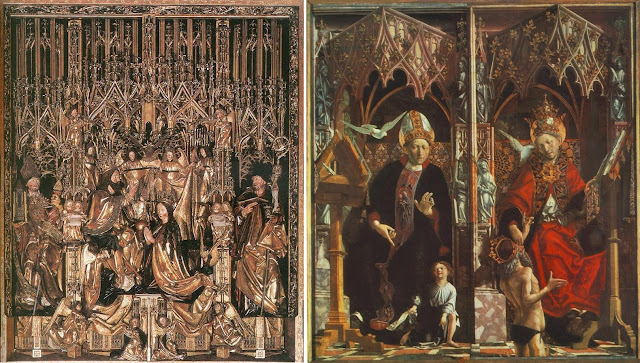Sculpture or Painting?
 |
| Altarpieces of Michael Pacher Left: Coronation of the Virgin Mary (1471-81, St. Wolfgang Altarpiece) Right: St. Augustine and St. Gregory (1483-84, Altarpiece of the Four Latin Fathers) |
The most characteristic works of the “Late Gothic” carver are wooden altar shrines, often large in size and incredibly intricate in detail. Such shrines were especially popular in the Germanic countries. One of the richest examples is the Coronation of the Virgin by the Tyrolean sculptor and painter Michael Pacher, in St. Wolfgang, Austria. Its lavishly gilt and colored forms make a dazzling spectacle as they emerge from the shadowy depth of the shrine under spiky flamboyant canopies; we enjoy it—but in pictorial rather than plastic terms. We have no experience of volume, either positive or negative; the figures and setting seem to melt into a single pattern of agitated, twisting lines that permits only the heads to stand out as separate entities… Did Pacher, the “Late Gothic” sculptor, feel unable to compete with the painter's rendering of three-dimensional bodies, and therefore chose to meet him in the pictorial realm, by extracting the maximum of drama from contrasts of light and shade?
Pacher's own work seems to support this view: some years after completing the St. Wolfgang shrine he made another altarpiece, this time with a painted center. Again we see large figures under ornate canopies the equivalent of a carved shrine—but now with far greater emphasis on space and volume. To say that Pacher is a painter when he sculpts, and a sculptor when he paints, is only a slight exaggeration: in this exchange, sculpture inevitably gets the short end of the bargain.
H.W. Janson
“Late Gothic Painting, Sculpture, and the Graphic Arts”
in History of Art
Comments
Post a Comment